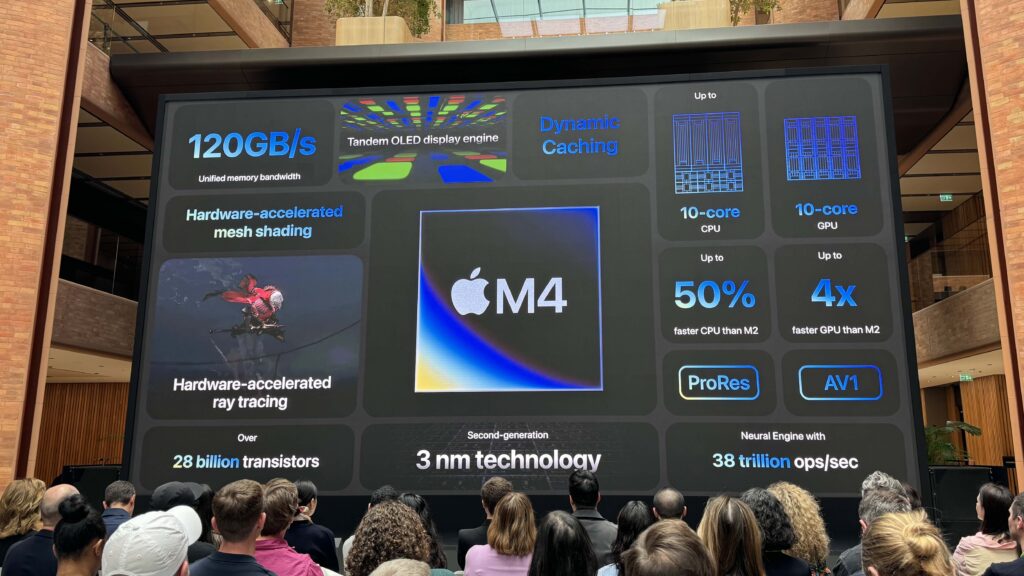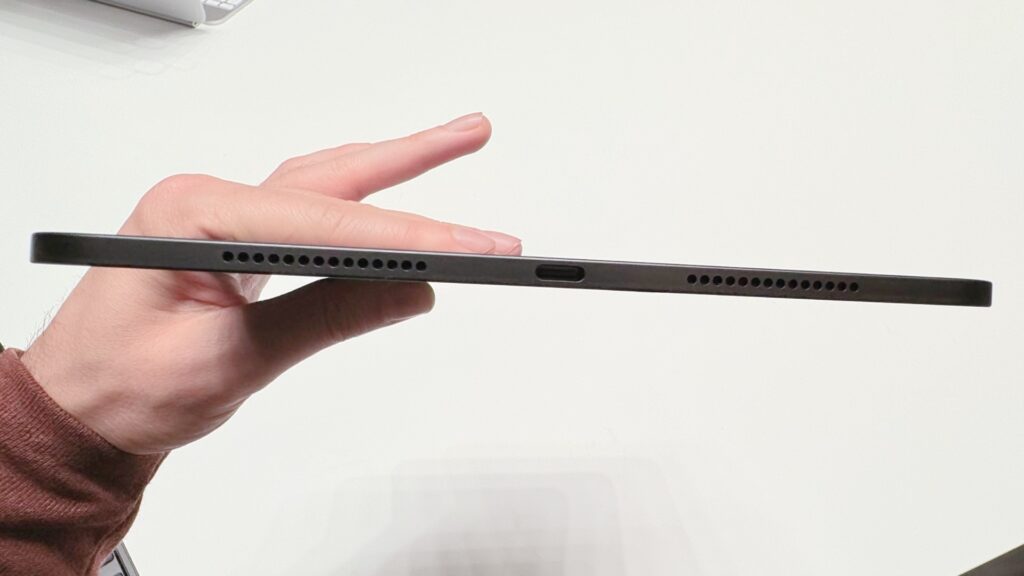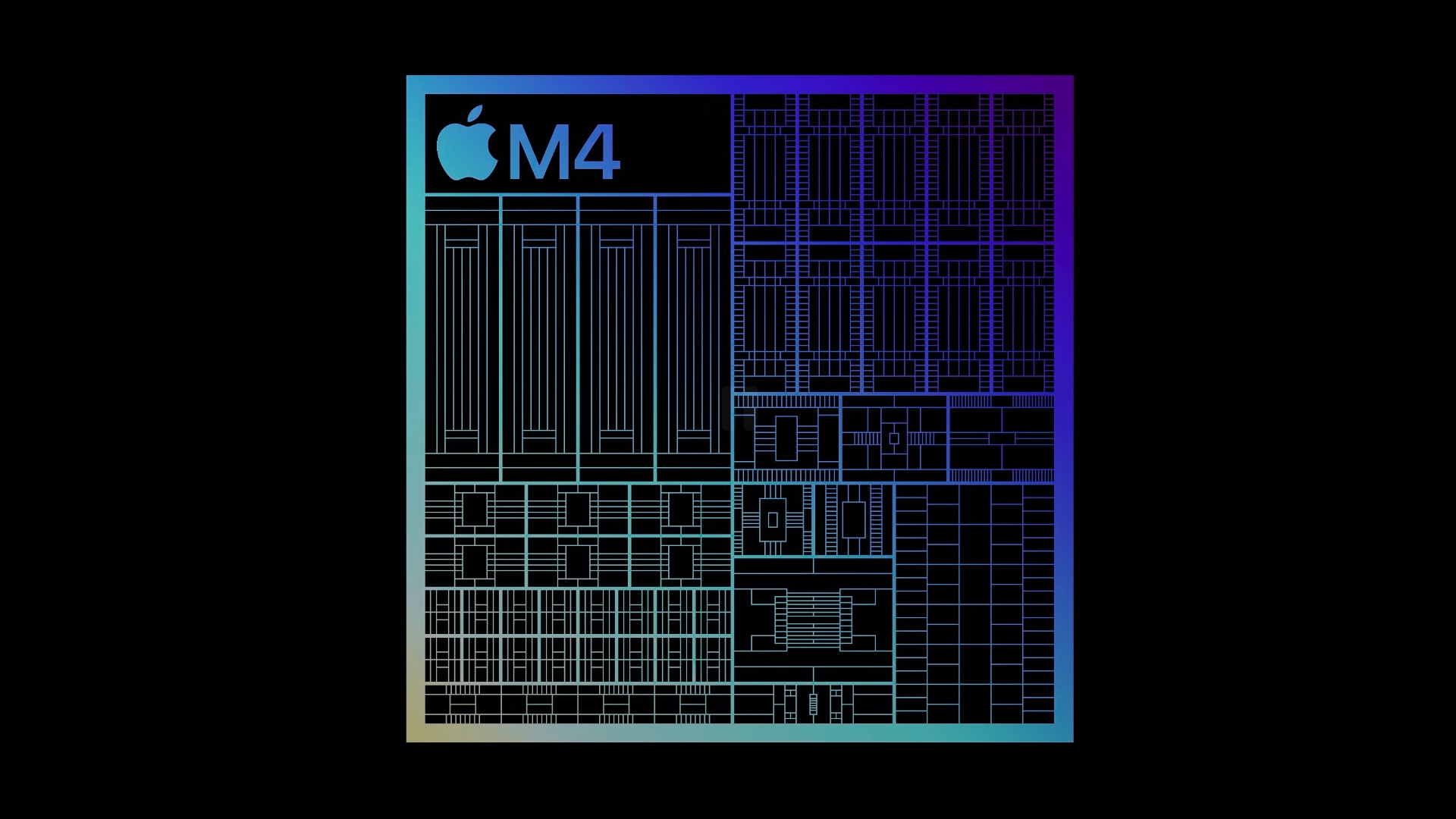Just six months after the introduction of the M3 chip, Apple kicked off the fourth generation of its Apple Silicon processors on May 7, with its new iPad Pro. The M4 chip introduces significant changes in terms of artificial intelligence, but it's not just about that.
M1 in November 2020, M2 in June 2022, then M3 in November 2023… Since the introduction of its first in-house chip for Macs, Apple has followed a relatively spaced schedule, with a leap forward every year and a half. The architecture of the chips is renewed each time, in almost every aspect.
Advertisement
This pace was not respected for the M4 chip, unveiled on May 17, 2024, only six months after the announcement of the M3 chip. An astonishing timing given the time needed to develop innovations – and which, in fact, raises questions about the real nature of the changes made. The new iPad Pros are the first to use it, while previous chips launched with Macs (devices that need much more power).
Apple M4: artificial intelligence finally at the level of an iPhone
Apple made no secret of it during its keynote: generative artificial intelligence is disrupting its plans. The brand, used to talking about “proactivity” or “automatic learning”, finally mentions the two letters “AI”. Even Apple cannot resist the pressure from the industry, which places artificial intelligence at the heart of everything.
During its keynote, Apple notably mentioned the “Neural Engine”, the component dedicated to AI that it has integrated into all its chips since 2017. The brand, accustomed to strict marketing vocabulary, even described it as “NPU ”, the term used by the rest of the industry. The message to be conveyed was this: the Neural Engine of the M4 chip is so powerful that it allows AI to be generated locally, without using the Internet. This foreshadows future functions for iPads and Macs, which should be announced in June.

If the Neural Engine of the M4 chip has the same number of cores as that of the M3 chip, still engraving in 3 nanometers (nm), it nevertheless introduces a size change: the maximum number of operations per second of which it is capable, according to Apple's internal testing.
Advertisement
Apple claims 38 trillion operations per second (38 TOPS) for the Neural Engine of the M4 chip, compared to 18 trillion operations per second (18 TOPS) on the M3 chip. This value even surpasses the A17 Pro of the iPhone 15 Pro, holder of the previous record with 35,000 billion operations per second (35 TOPS).
| Billions of operations per second (Apple benchmark) | Number of cores | |
|---|---|---|
| Apple M4 | 38,000 | 16 |
| Apple M3 | 18,000 | 16 |
| Apple M2 | 15,800 | 16 |
| Apple M1 | 11,000 | 16 |
| Apple A17 Pro | 35,000 | 16 |
| Apple A11 | 600 | 2 |
Apple specifies that its testing methodology involves processing a large volume of data in the form of FP16 (16-bit floating point number format, commonly used in machine learning performance testing). This approach effectively measures the maximum processing capacity of an Apple Silicon chip, while giving new chips the ability to process even smaller files, which will be used by its future language models. The maximum TOPS of an Apple Silicon chip are not comparable to those of a Qualcomm chip, since the methodology used by its rival is different, with smaller files. The brand claims 45 TOPS on its Snapdragon X Elite chip, which has not yet been released.
According to Apple, no NPU, regardless of brand, has the capability of an M4 chip today, with the A17 Pro in second place. This gives devices with an M4 chip (and iPhones) unprecedented potential for generative AI, when Apple is ready to unveil its first consumer features. RAM (8 GB or 16 GB on iPad Pros) will also play a role, but all M4 iPad Pros should be capable of the same feats, thanks to a greater bandwidth of 120 Gbps (102 Gb/s in M3). It remains to be seen how the M3 Macs will fare with their powerful, but inferior capabilities.


Why was the iPhone's Neural Engine more powerful than that of the Mac/iPad until then? For a matter of need. The iPhone processes your photos and messages when you sleep, while the Mac has less need for this type of activity. The emergence of generative AI is a game-changer.
Apple M4: a necessary chip for the finesse of the iPad Pro
In the space of six months, Apple has had time to revise its artificial intelligence plans… but does the M4 chip go further? A priori, this is indeed a new generation of chip.
First important change: the engraving is not the same. TSMC, Apple's Taiwanese subcontractor, now uses N3E engraving technology, instead of N3B. Both aim for 3nm engraving, but the new generation drastically improves power consumption (while probably reducing production costs). It turns out that power management is, according to Apple, the main reason for creating the M4 chip.


With its record thinness of 5.1 millimeters, the new iPad Pro is condemned to a thin and smaller battery. To guarantee autonomy of the same level as the previous generation, Apple must reduce the consumption of its tablet. It turns out that the Apple M4 chip offers, according to the brand, the power of an M2 chip by dividing its consumption by two, with the possibility of going much higher when necessary. Tandem OLED technology also involves a new controller for screens, capable of synchronizing two panels with sub-millisecond latency. This is one of the new features of the M4 chip, since an M3 chip would be incapable of it.
Are there any other changes elsewhere? Apple claims an M4 chip with 28 billion transistors, compared to 25 billion for an M3 chip. This is notably explained by the move from 8 cores for the CPU to 9 or 10 cores (3+6 or 4+6), which should improve multi-core performance (there should also be a small improvement in single-core core, but it will be impossible to measure without Mac M4). The graphics card is also entitled to an improvement, with an increase from 8 cores to 10 cores which, it seems, allows the performance of the ray tracingwhich will have an impact on video games (if developers use Apple technologies).
| M1 | M2 | M3 | M4 | |
|---|---|---|---|---|
| Engraving | 5nm (N5) | 5nm (N5P) | 3nm (N3B) | 3nm (N3E) |
| CPU (cores performance + energy) | 4+4 | 4+4 | 4+4 | 6+4 |
| GPU | 7 | 8 | 8 | 10 |
| NPU (TOPS) | 11 | 15.8 | 18 | 38 |
| Ray tracing | ❌ | ❌ | ✅ | ✅ |
| AV1 support (streaming) | ❌ | ❌ | ✅ | ✅ |
| Memory bandwidth | 68.25 GB/s | 102.4 GB/s | 102.4 GB/s | 120 GB/s |
Is the Apple M4 really a fourth generation Apple Silicon? Yes, but a generation with few major upheavals.
It remains crucial in Apple's strategy which, to achieve ever finer devices and local artificial intelligence, should ignore the M3 chip to gain power. It is unlikely that the M3 generation will last forever, while the new N3E process suits Apple on all levels.
Do we need the power of an M4 chip? This is another question, to which the answer is never the same from one user to another. Apple made several significant changes between the M1 and the M4 (finer engraving, better energy management, significantly improved graphics), but users would probably not notice any differences. In the case of the iPad Pro, the move to the M4 chip is justified in all cases by one characteristic: its extreme thinness.
